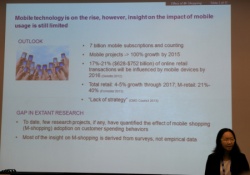
How many websites have you clicked on recently that haven't converted their format to mobile, frustrating your efforts to get the information you need in an effective and timely way?
Now researchers from Northwestern University have unearthed some provocative facts on how consumers utilize their mobile devices to buy groceries. With the global market for smartphones predicted to reach two billion by 2016, their findings should convince retailers planning marketing strategies and advertising campaigns that they need to pay attention to mobile.
In "On the Go: How Mobile Shopping Affects Customer Purchase Behavior," to be published in the June issue of the Journal of Retailing, doctoral student Rebecca Jen-Hui Wang and marketing professors Edward C. Malthouse and Lakshman Krishnamurthi explored changes in customers' spending patterns after adopting mobile shopping (M-shopping) via smartphones or tablets to compose, modify, or place grocery orders online.
The data was collected between 2011 and 2013 from an Internet-only retail grocer that operates mainly in the northeast US. Although 70 percent of transactions with the grocer were still being conducted via personal computer during this period, the researchers were able to identify key patterns among customers who were increasingly using mobile technology.
In one key finding, when customers used smartphones or tablets, whether in addition to or in place of, PCs, they spent more sessions shopping for groceries, perhaps composing their shopping list on the PC and later ordering via the mobile device. As the authors note, this finding suggests that M-shopping can lead to additional touch points between the M-shopper and the retailer.
Another finding was that low spenders in particular shop more often and place larger orders after adopting mobile. More generally, when customers M-shop, they tend either to purchase items they have purchased before - such as milk, pet food, and cereal - or from companies they're familiar with. The relatively small size of smartphone screens may discourage people from exploring unfamiliar items or brands, the authors theorize, and for this reason they suggest that firms focus on other channels, in addition to mobile, when launching new products.
Source: Journal of Retailing at New York University




